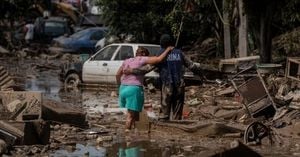President Donald Trump is once again putting crime at the forefront of the national conversation, launching a sweeping federal crackdown and pushing forward a new “comprehensive crime bill” that has already drawn sharp lines between Republicans and Democrats across the country. The latest moves, announced in late August 2025, have ignited fierce debate about the balance of public safety, states’ rights, and federal authority—especially as Trump’s administration moves to end cashless bail in the nation’s capital and signals a willingness to deploy federal forces in major cities like Chicago, New York, and Los Angeles.
On August 27, President Trump revealed that House Speaker Mike Johnson and Senate Majority Leader John Thune are fully backing his crime strategy. He took to Truth Social to declare, “It’s what our Country need, and NOW!” While the specifics of the bill are still under wraps, White House officials have made it clear that cashless bail—a system Trump has repeatedly blamed for spikes in violent crime—will be a primary target. Earlier that week, the president signed an executive order ending cashless bail in Washington, D.C., stating bluntly, “They kill people and they get out. We’re ending it. We’re starting by ending it in D.C.”
The White House has defended this aggressive approach. Press Secretary Karoline Leavitt told reporters, “President Trump’s approach of upholding law and order by letting our brave men and women in blue actually do their jobs to aggressively fight crime works.” According to TNND, Trump’s focus on crime has been a persistent theme since his 2024 campaign, and his latest actions are only intensifying the spotlight.
Trump’s federal interventions have not been limited to legislative proposals. In June, he sent National Guard troops into Los Angeles during the so-called “ICE riots,” and earlier this month, he ordered troops into Washington, D.C.—a move that drew immediate fire from Democratic officials, who accused him of federal overreach. Yet, even some of Trump’s critics have acknowledged tangible results. D.C. Mayor Muriel Bowser, a Democrat, conceded this week that the federal surge has helped drive down crime. “We know that when carjackings go down, when the use of guns goes down, when homicide or robbery go down, neighborhoods feel safer and are safer. So this surge has been important to us for that reason,” Bowser said, pointing to an 87% drop in carjackings and a 15% decrease in overall crime compared to the same 20-day period last year.
Still, the expansion of federal law enforcement into local jurisdictions remains deeply contentious. Trump has floated the idea of sending federal deployments to other cities, including Chicago and New York. Illinois Governor J.B. Pritzker didn’t mince words, calling Trump’s proposal “exactly the type of overreach that our country’s founders warned against. What President Trump is doing is unprecedented and unwarranted. It is illegal.” Leavitt countered that Pritzker should spend less time “demonizing the police” and more time addressing crime in his own state.
Public opinion, however, seems to be tilting toward Trump’s side of the argument. A recent AP-NORC poll conducted with the University of Chicago found that a majority of Americans perceive crime as a serious problem in big cities, and 55% say it is acceptable for the National Guard or military to assist local police. This data underscores a growing sense of urgency among voters, many of whom are demanding swift action to restore safety to urban neighborhoods.
But the debate is not limited to the federal level. In California, Governor Gavin Newsom has announced the deployment of “crime suppression teams” from the California Highway Patrol (CHP) to cities across the state, including San Diego, Inland Empire, Los Angeles, Central Valley, Sacramento, and the San Francisco Bay Area. Newsom’s approach is pointedly different from Trump’s, emphasizing partnership with local communities rather than top-down federal intervention. “When the state and local communities work together strategically, public safety improves. While the Trump Administration undermines cities, California is partnering with them—and delivering real results,” Newsom stated in a press release.
Los Angeles Mayor Karen Bass echoed this collaborative spirit, saying, “The best way to address crime and other top challenges is through partnership and this is an example of that.” CHP Commissioner Sean Duryee added, “By combining resources, intelligence, and personnel, we can better disrupt criminal activity and strengthen the safety and security of communities across California.” The impact of these efforts is already apparent: in Oakland, crime has declined by 34% since 2024, while in Bakersfield, homicides have dropped 57% and shootings by 60%.
Despite these successes, tensions between Trump and Newsom have been running high. Newsom has been openly critical of the president’s tactics, using social media to highlight what he sees as the dangers of federal overreach. “The President is doing things TO PEOPLE. California is doing it WITH PEOPLE,” Newsom posted on X, drawing a sharp distinction between the two leaders’ philosophies. The legal battle over Trump’s use of federal troops in Los Angeles during the July immigration protests is still unresolved, with a court decision pending on whether the deployment violated the Posse Comitatus Act, which prohibits the use of military for civilian law enforcement. California Attorney General Rob Bonta didn’t hold back, calling Trump’s actions an “absolute, complete, transparent, blatant, brazen violation of the law. The Posse Comitatus Act said you cannot use military to engage in civilian law enforcement on American soil. Period, full stop.”
Amid these dueling strategies, the political stakes are rising. Many observers see Newsom’s crime suppression initiative as more than just a policy move—it’s a deliberate attempt to bolster the Democratic Party’s public image on crime ahead of his expected 2028 presidential bid. For Republicans, Trump’s tough-on-crime stance has long been a winning message with voters, and the current climate appears to be no exception.
The national conversation is only set to intensify. The House Oversight and Government Reform Committee has scheduled a September 18 hearing with Mayor Bowser and other D.C. officials to scrutinize crime trends in the capital and assess the impact of recent federal interventions. Meanwhile, media coverage has been relentless: on August 28, Fox Business aired a segment titled “Rep Fitzgerald touts Trump’s ‘big, beautiful bill,’ DC crime crackdown,” highlighting the administration’s efforts and the growing political divide.
As summer turns to fall, the debate over how best to fight crime in America’s cities shows no signs of cooling off. In the end, the clash between federal muscle and local partnership may shape not only the safety of neighborhoods but also the trajectory of the 2028 presidential race.




